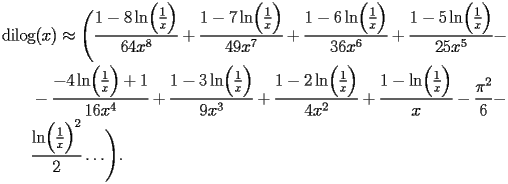LI2 Dilogarithm
LI2.1 Introduction |
top up back next into bottom |
Let
 be a complex variable of
be a complex variable of
 .The function Dilogarithm (noted
.The function Dilogarithm (noted
 ) is defined by the following third order differential equation
) is defined by the following third order differential equation
| LI2.1.1 |
The initial conditions of LI2.1.1 at
 are not simple to state, since
are not simple to state, since
 is a (regular) singular point.
is a (regular) singular point.
LI2.2 Series and asymptotic expansions |
top up back next into bottom |
LI2.2.1 Asymptotic expansion at
|
top up back next into bottom |
LI2.2.1.2 General form |
top up back next into bottom |
| LI2.2.1.2.1 |
 satisfy the recurrence
satisfy the recurrence
| LI2.2.1.2.2 |
| LI2.2.1.2.3 |
| LI2.2.1.2.4 |













